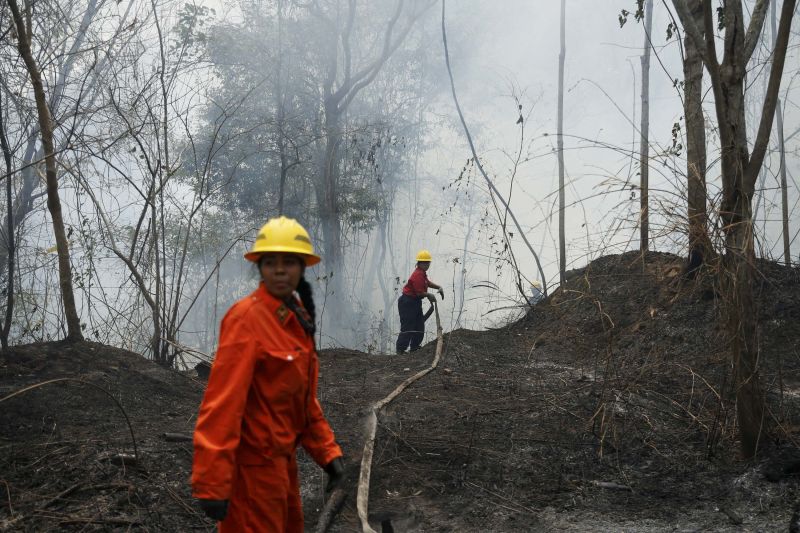Venezuela is battling a record number of wildfires, according to data released on Monday, as a climate change-driven drought plagues the Amazon rainforest region.
Satellites registered more than 30,200 fire points in Venezuela from January to March, the highest level for that period since records started in 1999, according to Brazil’s Inpe research agency, which monitors all of South America.
That includes fires in the Amazon, as well as the country’s other forests and grasslands.
Man-made fires that are often set to clear land for agriculture are spreading out of control thanks to high temperatures and low rainfall in northern South America, as well as a lack of prevention planning, researchers say.
Scientists blame the drought on climate change and El Niño, a natural warming in the eastern Pacific that roils global weather patterns.
While the rainy season has brought relief in recent months further south in Brazil’s Amazon, the fires in Venezuela could be a worrying sign for what’s ahead once the dry season arrives there, said Manoela Machado, a fire researcher at University of Oxford.
“Everything is indicating we’re going to see other events of catastrophic fires — megafires that are huge in size and height,” Machado said.
The region’s most intense fires typically occur in Brazil in August and September along the southeastern edge of the Amazon, where deforestation for agriculture is most aggressive.
In Venezuela, roughly 400 firefighters fought a major blaze over the Easter holiday weekend that is threatening the lush Henri Pittier National Park, a beachfront preserve with rare cloud forests, according to the national park service.
“I am shocked, if not to say alarmed, by this fire,” said Carlos Carruido Perez, who lives nearby. “I had never seen a fire of this magnitude and this damage to the environment.”
Venezuela’s environment ministry said last month it had launched a coordinated effort with helicopters and additional equipment to fight the fires in Henri Pittier.
The ministry said last week it was mounting further firefighting efforts along a highway that cuts through the park.
In Venezuela’s Amazon region further south, there are 5,690 active fires as of late March, according to NASA data. That accounts for more than half of all the blazes burning in the entire Amazon across nine countries.
The fires are blanketing with smoke Guayana City, Venezuela’s largest urban center in the Amazon, according to a Reuters witness.
In the nearby town of Uverito, authorities evacuated 315 families from their homes due to the threat of fire, local media reported.
Some 360 square kilometers have burned in Uverito, an area six times the size of Manhattan, according to Jose Rafael Lozada, a forestry engineer and retired professor at Universidad de Los Andes in Merida, Venezuela.
Miracle-working firefighters
The same hotter, drier weather helping to feed fires in Venezuela is driving fires across the border in Brazil’s Roraima state, which are threatening indigenous reserves there.
Venezuela and Roraima have seen only 10% to 25% of their normal rainfall levels in the last 30 to 90 days, said Michael Coe, director of the tropics program at the US-based Woodwell Climate Research Center.
The region is in a vicious cycle in which climate change contributes to dry and hot conditions that worsen fires, with those fires in turn releasing greenhouse gasses that further drive climate change, Lozada said.
Fires generally do not occur naturally in the wet rainforest. Humans set the vast majority of fires to clear forest for farms and ranches, a long-held practice, he said.
“People burn the same, but the drought is more extreme. The vegetation is drier, the rains are scarce and we see the consequences: a small burn turns into a fire of great magnitude,” Lozada added.
The Amazon drought has upended life in the world’s largest rainforest since last year as it pushed river levels to record lows, killed endangered dolphins and disrupted boats carrying food and medicine to dozens of cities.
Despite a wealth of information tracking fires and flagging the climate risks that lie ahead, governments throughout the region are still failing to mount a robust response to prevent and combat the fires, Oxford’s Machado said.
Governments should ban setting fires during dry periods, mount faster targeted response to stop fires before they get out of control and hire firefighters year-round instead of temporarily, she said.
In Venezuela, Lozada, firefighters and other experts said the government response was lacking.
Venezuela’s information ministry and parks service did not respond to requests for comment.
“The forest is unprotected due to a lack of equipment to fight forest fires,” said William Lopez, a union leader with the state-owned forestry company Maderas del Orinoco.
“Firefighters have to work miracles to be able to fight fires without equipment.”

